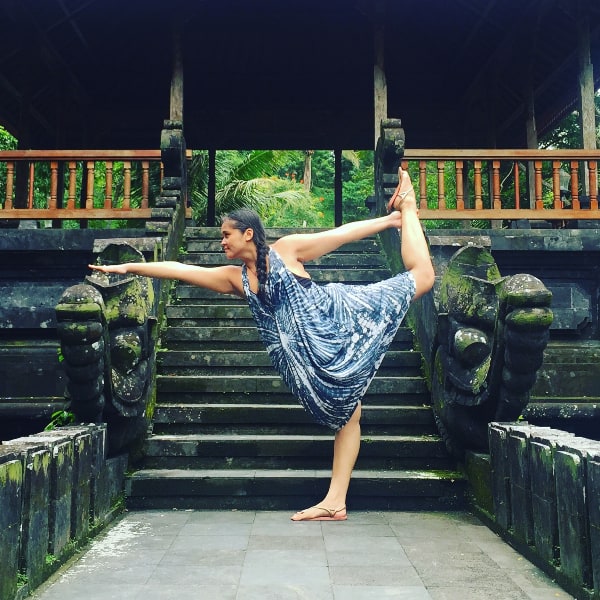This post may contain affiliate links. Please read our disclosure for more info.
One of the most iconic poses in yoga, Tree pose, or Vrksasana, is instantly recognizable and practiced by many. Practicing this posture requires balance, strength, and flexibility and there are many variations suited for every level of yogi.
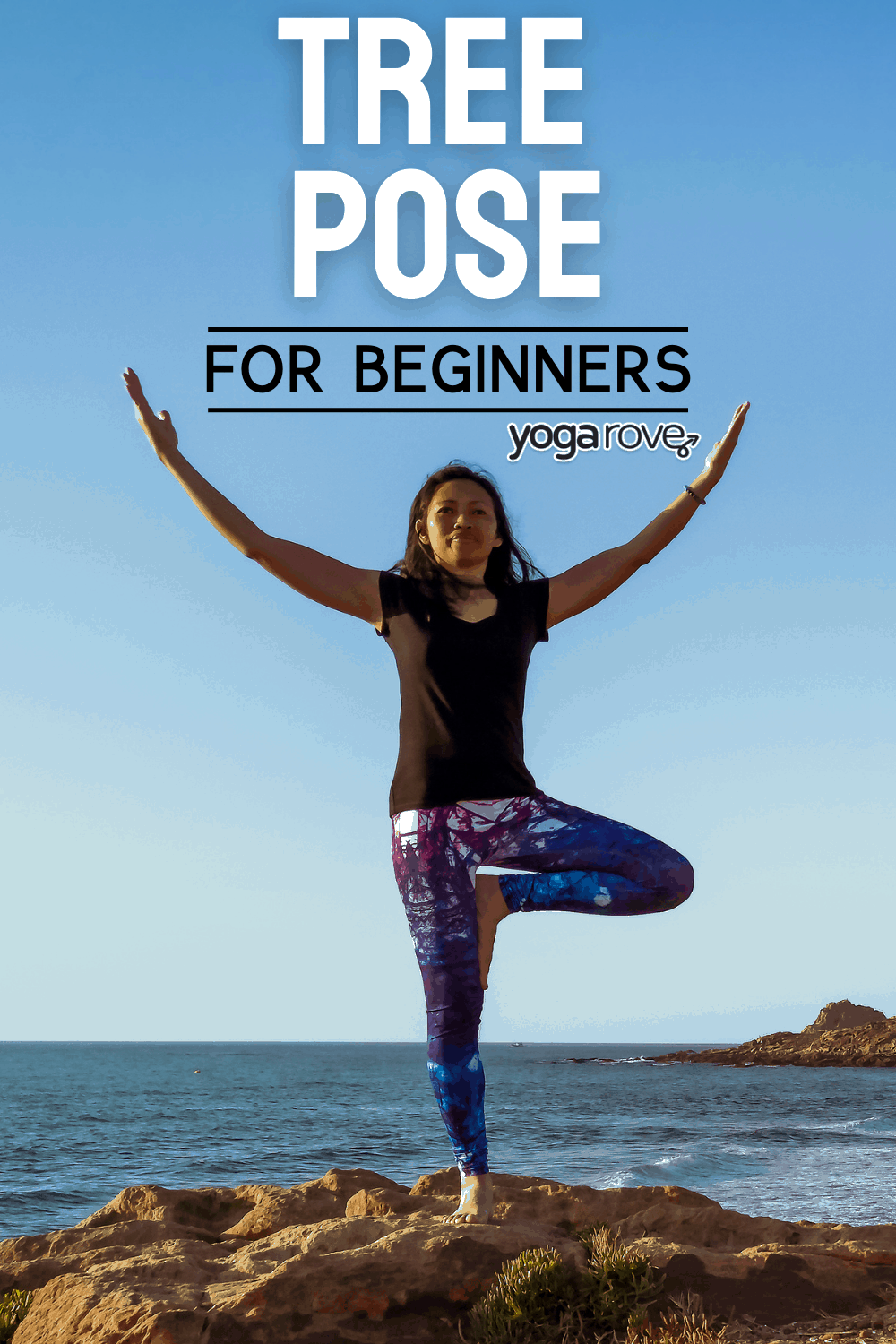
When you are in Tree pose, you feel strong and tall—just like an actual tree. This standing and balancing posture can help you to feel grounded, spacious, and open, and is often found in many Hatha and Vinyasa yoga classes.
Benefits of Tree Pose
Practicing Tree pose can feel challenging at first. Finding your balance can take some time, but feeling your way through the pose can be a rewarding journey. This beautiful posture has many physical and emotional benefits. Some benefits of Tree pose are:
- Grounds your body and your energy
- Improves your concentration
- Relieves stress
- Relieves cramps in the body
- Improves your balance
- Strengthens your leg muscles
- Aligns the body
- Strengthens your ankles and toes
Warming Up for Tree Pose
Practicing Tree pose requires concentration, strength, and stability. Before coming into Tree pose, warm your body up with a few Sun Salutations and postures that open up your body for balancing on one leg. Some poses that you can practice include:
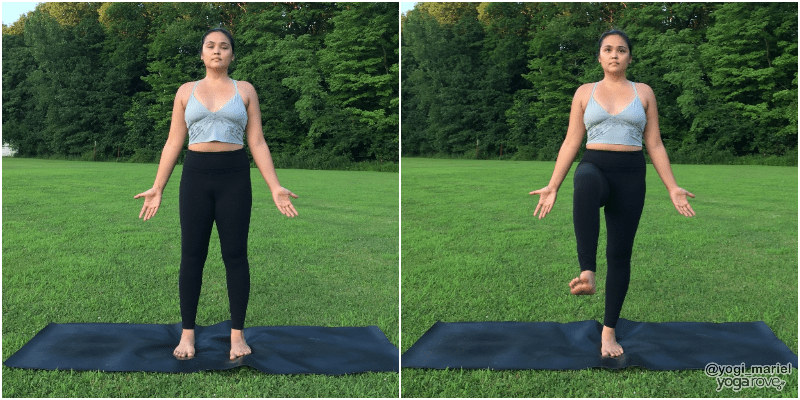
Mountain Pose
Find a strong base before you move on to balancing on one leg.
- Stand with your feet hips-width distance apart, and your arms alongside your body.
- Roll your shoulders up, back, and down, and lift your chest up. Feel your upper body lift up out of your waist and feel both of your feet firmly rooted down to the floor.
- Press your big toes and heels onto the mat and engage your thigh muscles by lifting your kneecaps up and hugging your thigh muscles to the bone.
One-Legged Mountain Pose
This is a great pose to practice to ease into your Tree pose.
- Stand tall in Mountain pose and feel both of your feet rooting firmly to the floor.
- Shift your weight to your right leg and lift your left foot off the mat.
- Bend your left knee and flex your left toes right under your knee so that you are creating a 90-degree angle with your left leg. Keep your arms alongside your body, your spine straight, and your chest lifted.
- Engage your right thigh muscle and keep rooting down with your right big toe and heel.
- Stay for 5 breaths and repeat on the left side.
How to Practice Tree Pose
To find balance and strength on both sides of your body, make sure to practice this posture on your right and your left leg.
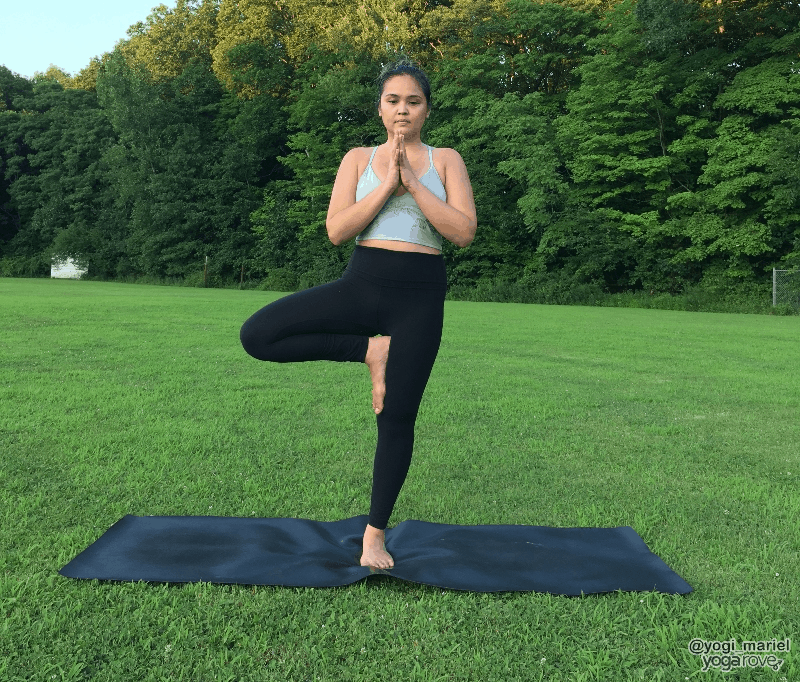
To practice Tree Pose:
- Begin in Mountain pose with your feet flat on the floor, legs engaged, and arms alongside your body.
- Shift your weight to your right foot and lift your left foot off the floor. Come into a One-Legged Mountain pose with your left leg at a 90-degree angle and your right leg straight and strong.
- Place your left hand on your left knee and open your knee to the left side of the room.
- With the help of your hand, gently place the left sole of your foot to your right inner thigh, calf, or ankle. Make sure that your foot is not directly on your knee joint, but above or below your knee.
- Stabilize your standing leg by lifting your kneecap up and engaging your thigh muscle. Keep pressing your right big toe and heel down onto the mat.
- Push your left foot into your right leg, and your right leg into your left foot. Hug everything toward the midline of your body.
- Place both of your palms together and bring your thumbs to the center of your chest.
- Roll your shoulders up, back, and down, and keep your heart open and lifted.
- Gaze either at your fingertips or straight in front of you with a soft gaze.
- Stay for 5 breaths and repeat on the left side.
Common Misalignments
It is common for beginners to have some misalignments in the body when first practicing Tree pose. Focus on finding proper alignment and building strength and flexibility from there. Here are some common misalignments in Tree pose:
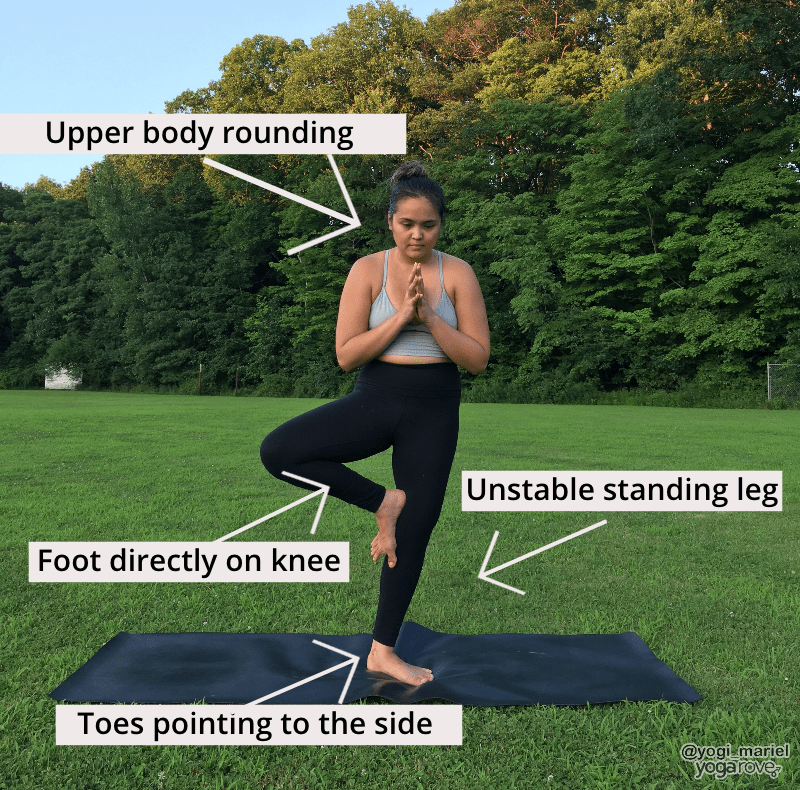
- Alignment of your toes: It is important that your toes are pointing straight forward in Tree pose, in order to keep the alignment of your hips and your body. Notice if your toes are pointing too far inward or turning out, and make sure that the toes of your standing leg point straight forward to the top of your mat.
- Unstable standing leg: If you are bending your knee and feeling wobbly in Tree pose, check that you are engaging your thigh muscle and lengthening the back of your knee. Feel a solid base and foundation by pressing your big toe mound down to the ground and feeling the energy rise up through your standing leg.
- Hyper extending your knee: At the same time, it is also imperative that you avoid a hyperextended knee. This is when you push your knee back and ‘lock’ your knee, so much so that you are relying on flexibility instead of strength. This can lead to injury, as you are placing a lot of pressure on your joints, without strengthening and activating the muscles around it.
- Foot directly on your knee joint: Place your foot either above or below your knee in Tree pose. If it is challenging to lift your foot up to your inner thigh, modify it by placing it on your inner ankle or calf muscle. Slowly, as your body begins to open, you can lift it up higher toward your inner thigh, but stay off of your knee.
Modifications
If you feel a little wobbly in your Tree pose, try one of these modifications:
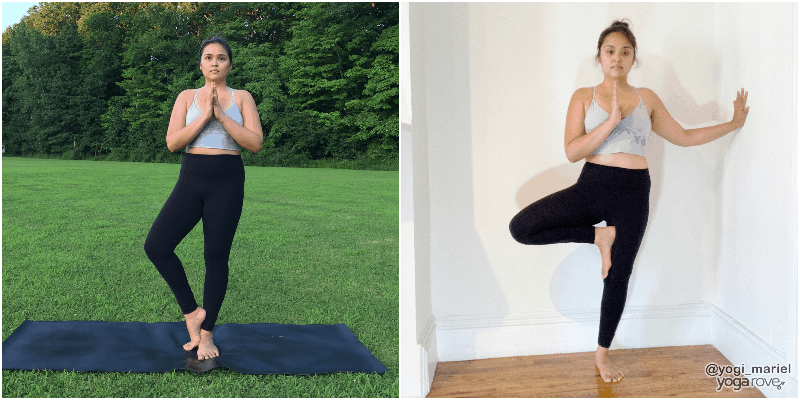
- Place your foot lower on your leg: Avoid placing your foot directly on your knee, and take your foot down to your calf muscle or your ankle. If you are still a little wobbly with your foot on your ankle, you can place your toes on the mat for more support and stability, while keeping your foot on your ankle.
- Use a wall or a chair: If it is challenging to balance on one leg, use a chair or the wall. If you are using the wall, practice Tree pose near the wall and place your hands on the wall to balance. If you are using a chair, place the chair on either side of your body or in front of you, and place on or both hands on your chair for support.
- Gaze down: In Tree pose, your dristhi, or gaze, should be right in front of you or right at your fingertips. However, this can be challenging for some yogis. If you find this challenging, shift your gaze to the floor a few inches in front of you. As you begin to feel comfortable, you can start to shift your gaze up.
- Place your hands on your hips: Instead of bringing your hands to your heart center, you may find it easier to balance with your hands on your hips. Work on lifting your upper body out of your waist and engaging the upper body to stay lifted. The lower and upper body should both be engaged and strong in Tree pose.
Tips for Beginners
- Modify if you need: If it feels uncomfortable to lift your foot up toward the inner thigh, modify by placing it on your inner calf or inner ankle. With time, your flexibility will increase and you will be able to gradually lift your foot up higher on your leg.
- Engage your upper body: Because this is a standing balancing pose, we can tend to place more emphasis on the lower body in Tree pose. However, engage the upper body as well so that your lower body can better support your entire body. Keep your upper body open and engaged with your chest lifted and collar broad.
- Build up your strength and flexibility: Tree pose requires open hips and hamstrings and a strong standing leg. Keep building your strength and flexibility with other yoga poses in ordered to find ease in Tree pose.
Variations in Tree Pose
Try these different variations next time you are in Tree pose:
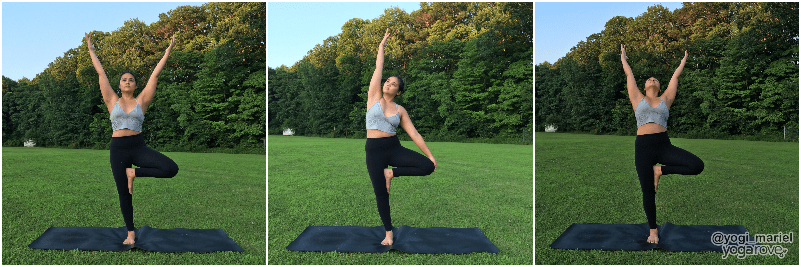
- Lift your arms up overhead: Instead of taking your hands to a prayer position at the center of your chest, lift your arms up overhead. Allow your palms to face each other, relax your shoulders away from your ears, and lift your heart up toward to the sky.
- Take a side bend: With your arms up overhead, release on arm down by your side and stretch the other arm up and over to find a stretch in your side body. Repeat on the opposite side.
- Find a backend: Keeping the arms up overhead, gently push your hips forward, lift your upper body out of your waist, and begin to lift your heart and take your arms back. Keep your standing leg super strong as you find the backbend in your spine.
- Close your eyes: Keeping your hands at your heart or taking them up overhead, challenge yourself by closing your eyes in Tree pose. Start with a few breaths and see if you can keep you eyes closed for 5 breaths in Tree pose.
Contraindications
If you are recovering from an ankle or knee injury, take caution when practicing Tree pose. Be sure to modify if you feel any pain or discomfort, or skip the pose altogether. If you are prone to vertigo, take it slow while balancing on one leg.
Remember that it is totally normal to feel a little wobbly when first practicing Tree pose. Enjoying finding your stability, strength, and flexibilty in the posture, and work on connecting to that grounding and stable energy of a tree!


